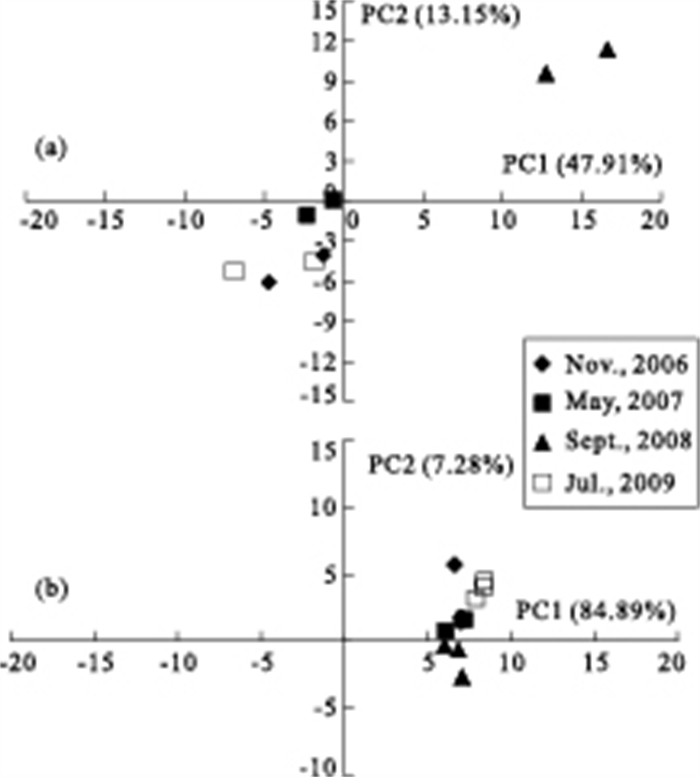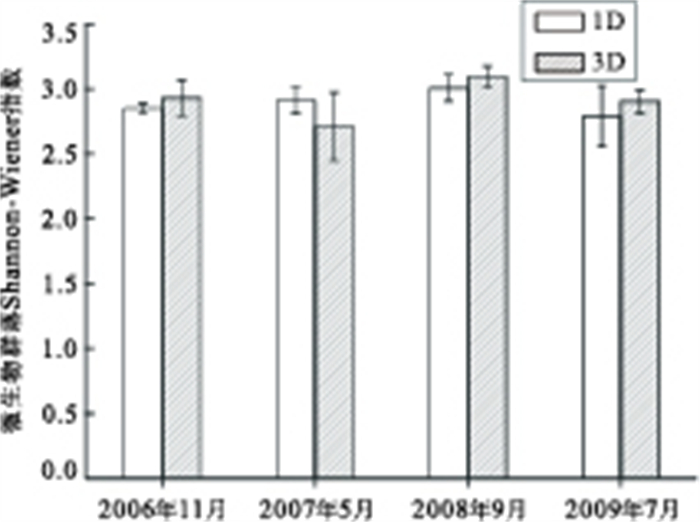Spatial and Seasonal Variations of Microbial Communities in Dripping Water from the Heshang Cave, Central China
-
摘要: 为了考察现代微生物群落对环境因子的响应关系及其在古气候重建中的应用潜力, 利用微生物学传统的培养计数、荧光染色总菌计数和BIOLOG的ECO微平板等技术对湖北省清江和尚洞内不同地点的滴水由内至外进行了空间和季节性的动态监测, 4个滴水点由内向外编号依次为1D、3D、4D和5D.结果证实湖北清江和尚洞洞穴滴水中存在一定数量的微生物.不同样点微生物的代谢活性不同, 1D样品中的微生物群落代谢活性最高, 3D表现出与1D相似的代谢特征, 但平均颜色变化率(AWCD: 微生物对碳源的利用程度, 颜色变化率越高, 表明微生物代谢越旺盛)较1D小, 4D和5D样品在接种24h后平均颜色变化率(AWCD)基本保持不变.对微生物代谢较为旺盛的1D、3D两个样品中不同时间内微生物群落的多样性指数进行分析, 表明洞穴滴水中微生物多样性相对稳定, 随采样季节的变化不大.相对于3D、1D的4个不同季节(采样时间)微生物群落对碳源种类的利用上存在一定差异.1D水样在2006秋季(2006年11月份)、2007春季(2007年5月)和2009年夏季(2009年7月份)微生物群落利用碳源种类上比较接近, 而在2008年初秋(2008年9月)碳源利用种类与前三者的差异明显.与1D相比, 3D的4个不同采样时间的滴水微生物群落在主成分1和主成分2的得分系数比较接近, 群落碳源代谢功能多样性差别不大.这种变化可能反映了不同季节滴水中可溶有机质成分(DOC)的变化及微生物群落成分的变化, 暗示了微生物群落结构变化在指示气候变化应用中的巨大潜力.但微生物群落多样性与代谢功能多样性与气候因子之间的关系尚需深入研究.Abstract: Dripping water was seasonally collected from several sites (denoted as site 1D, 3D, 4D and 5D toward the cave entrance respectively) inside the oligotrophic Heshang cave, Central China, to detect the metabolic activities of microbial communities in response to rainfall and temperature. Viable counting method, the DAPI staining technique as well as Biolog Eco microplates were exploited for microbial counting and metabolic changes of microbial communities. Results confirm the existence of microbes in the dripping water though the microbial biomass is as low as that in the deep sea water column. The metabolic activities of microbial communities varied with sites as indicated by the average well color development (AWCD) values in Biolog ECO microplates. Microbes in site 1D showed the strongest metabolic activities followed by those in site 3D. Microbial communities in the sites near the cave entrance, such as site 4D and site 5D, however, displayed the weakest metabolic activities as shown by the invariant AWCD values after 24-hour incubation. Similar microbial diversity indices were observed between different sites such as site 1D and site 3D, and even among different seasons. This indicates the presence of a fairly stable microbial diversity in the dripping water, probably due to the oligotrophic condition in the cave. However, the carbon utilization pattern of microbial communities in site 1D differed greatly among seasons; the pattern in Sept. 2008 is distinguishable from those in other sampling periods. The seasonal variation in carbon utilization might arises from the seasonal changes of dissolved organic matter or the changes in the flow rate of dripping water. Noticeably, such kind of seasonal variation in the carbon utilization was not reproduced in site 3D. Yet we need further investigations to determine the relationship between the changes in microbial community and the climate factors such as temperature and rainfall.
-
Key words:
- karst cave /
- climate change /
- microbiology /
- community diversity
-
表 1 湖北清江和尚洞滴水微生物计数结果
Table 1. Total microbial counts in dripping waters of Heshang cave, Hubei
样品号 琼脂平板计数(CFU·mL-1) 荧光染色计数(Cells·mL-1) 可培养比率(%) 2008.09 1D 4.85×102 7.668×104 0.63 2008.09 3D 2.18×102 2.628×104 0.83 -
Amann, R.I., Ludwig, W., Schleifer, K.H., 1995. Phylogenetic identification and in situ detection of individual microbial cells without cultivation. Microbiological Reviews, 59(1): 143-169. doi: 10.1128/mr.59.1.143-169.1995 Atlas, R.M., Bartha, R., 1993. Microbial ecology: fundamentals and applications. Benjamin-Cummings Press, CA. Baker, A., Smart, P.L., Edwards, R.L., et al., 1993. Annual growth banding in a cave stalagmite. Nature, 364: 518-520. doi: 10.1038/364518a0 Baldini, J.U.L., McDermott, F., Fairchild, I.J., 2006. Spatial variability in cave drip water hydrochemistry: implications for stalagmite paleoclimate records. Chemical Geology, 235(3-4): 390-404. doi: 10.1016/j.chemgeo.2006.08.005 Balestra, G.M., Misaghi, I.J., 1997. Increasing the efficiency of the plate counting method for estimating bacterial diversity. Journal of Microbiological Methods, 30(2): 111-117. doi: 10.1016/S0167-7012(97)00056-0 Barton, H.A., Taylor, N.M., Lubbers, B.R., et al., 2006. DNA extraction from low-biomass carbonate rock: an improved method with reduced contamination and the low-biomass contaminant database. Journal of Microbiological Methods, 66(1): 21-31. doi: 10.1016/j.mimet.2005.10.005 Chelius, M.K., Moore, J.C., 2004. Molecular phylogenetic analysis of archaea and bacteria in Wind cave, South Dakota. Geomicrobiology Journal, 21: 123-134. doi: 10.1080/01490450490266389 Cowen, J.P., Giovannoni, S.J., Kenig, F., et al., 2003. Fluids from aging ocean crust that support microbial life. Science, 299(5603): 120-123. doi: 10.1126/science.1075653 Faegri, A., Torsvik, V.L., Goksoyr, J., 1977. Bacterial and fungal activities in soil: separation of bacteria and fungi by a rapid fractionated centrifugation technique. Soil Biology & Biochemistry, 9(2): 105-112. doi: 10.1016/0038-0717(77)90045-1 Franklin, R.B., Garland, J.L., Bolster, C.H., et al., 2001. Impact of dilution on microbial community structure and functional potential: comparison of numerical simulations and batch culture experiments. Applied and Environmental Microbiology, 67(2): 702-712. doi: 10.1128/AEM.67.2.702-712.2001 Fredrickson, J.K., Balkwill, D.L., Zachara, J.M., et al., 1991. Physiological diversity and distributions of heterotrophic bacteria in deep cretaceous sediments of the Atlantic coastal-plain. Applied and Environmental Microbiology, 57(2): 402-411. doi: 10.1128/aem.57.2.402-411.1991 Gargiulo, G., Bradford, S.A., Simunek, J., et al., 2008. Bacteria transport and deposition under unsaturated flow conditions: the role of water content and bacteria surface hydrophobicity. Vadose Zone Journal, 7(2): 406-419. doi: 10.2136/vzj2007.0068 Garland, J.L., 1996. Analytical approaches to the characterization of samples of microbial communities using patterns of potential C source utilization. Soil Biology & Biochemistry, 28(2): 213-221. doi: 10.1016/0038-0717(95)00112-3 Garland, J.L., Mills, A.L., 1991. Classification and characterization of heterotrophic microbial communities on the basis of patterns of community-level sole-carbon-source utilization. Applied and Environmental Microbiology, 57(8): 2351-2359. doi: 10.1128/aem.57.8.2351-2359.1991 Genty, D., Deflandre, G., 1998. Drip flow variations under a stalactite of the Père Noel cave (Belgium): evidence of seasonal variations and air pressure constraints. Journal of Hydrology, 211(1-4): 208-232. doi: 10.1016/S0022-1694(98)00235-2 Glimm, E., Heuer, H., Engelen, B., et al., 1997. Statistical comparisons of community catabolic profiles. Journal of Microbiological Methods, 30(1): 71-80. doi: 10.1016/S0167-7012(97)00046-8 Groth, I., Saiz-Jimenez, C., 1999. Actinomycetes in hypogean environments. Geomicrobiology Journal, 16: 1-8. doi: 10.1080/014904599270703 Grove, J.A., Kautola, H., Javadpour, S., et al., 2004. Assessment of changes in the microorganism community in a biofilter. Biochemical Engineering Journal, 18(2): 111-114. doi: 10.1016/S1369-703X(03)00182-7 Guckert, J.B., Carr, G.J., Johnson, T.D., et al., 1996. Community analysis by Biolog: curve integration for statistical analysis of activated sludge microbial habitats. Journal of Microbiological Methods, 27(2-3): 183-197. doi: 10.1016/S0167-7012(96)00948-7 Haack, S.K., Garchow, H., Klug, M.J., et al., 1995. Analysis of factors affecting the accuracy, reproducibility, and interpretation of microbial community carbon source utilization patterns. Applied and Environmental Microbiology, 61(4): 1458-1468. doi: 10.1128/aem.61.4.1458-1468.1995 Haack, S.K., Garchow, H., Odelson, D.A., et al., 1994. Accuracy, reproducibility, and interpretation of fatty acid methyl ester profiles of model bacterial communities. Applied and Environmental Microbiology, 60(7): 2483-2493. doi: 10.1128/aem.60.7.2483-2493.1994 He, L.Y., Hu, C.Y., Cao, Z.H., et al., 2008. Correspondences of Heshang cave temperature to climatic change in Qingjiang, Hubei. Carsologica Sinica, 27(3): 273-277, 282 (in Chinese with English abstract). http://en.cnki.com.cn/Article_en/CJFDTOTAL-ZGYR200803015.htm Hobbie, J.E., Daley, R.J., Jasper, S., 1977. Use of nuclepore filters for counting bacteria by fluorescence microscopy. Applied and Environmental Microbiology, 33(5): 1225-1228. doi: 10.1128/aem.33.5.1225-1228.1977 Hollibaugh, J.T., 1994. Relationship between thymidine metabolism, bacterioplankton community metabolic capabilities, and sources of organic matter. Microbial Ecology, 28(2): 117-131. doi: 10.1007/BF00166800 Hu, C.Y., Henderson, G.M., Huang, J.H., et al., 2008. Report of a three-year monitoring programme at Heshang cave, Central China. International Journal of Speleology, 37: 143-151. doi: 10.5038/1827-806X.37.3.1 Hu, C.Y., Huang, J.H., Yang, G.Q., et al., 2002. Determination of trace dissolved silicon in a stalagmite from Qingjiang, Hubei, China, and its paleoclimatic significance. Earth Science—Journal of China University of Geosciences, 27(4): 453-455 (in Chinese with English abstract). http://en.cnki.com.cn/Article_en/CJFDTOTAL-DQKX200204017.htm Hu, K., Wang, L.B., 2007. Application of biology microplate technique to the study of soil microbial ecology. Chinese Journal of Soil Science, 38(4): 819-821 (in Chinese with English abstract). http://search.cnki.net/down/default.aspx?filename=TRTB200704042&dbcode=CJFD&year=2007&dflag=pdfdown Huang, X.Y., Pu, Y., Cui, J.W., 2007. Distributions of fatty acids in the drip water at Heshang cave, Hubei Province and their ecological applications. Quatemary Science, 27(3): 401-407 (in Chinese with English abstract). http://en.cnki.com.cn/Article_en/CJFDTOTAL-DSJJ200703011.htm Huang, X.Y., Pu, Y., Xie, S.C., et al., 2007. Distributions of microbial fatty acids in drip water, stalagmite and overlying soils in Heshang cave, Hubei Province. Journal of China University of Geosciences, 18 (Special issue): 366-367. http://www.airitilibrary.com/Publication/Index/WFHYXW174772 Jia, R., Hu, C.Y., Qiu, H.O., et al., 2007. Natural fluorescent substance as tracer for karst groundwater: a case study on Heshangdong of Qingjiang, Hubei. Carsologica Sinica, 26(3): 262-265 (in Chinese with English abstract). http://www.zhangqiaokeyan.com/academic-journal-cn_carsologica-sinica_thesis/0201252316210.html Karner, M.B., DeLong, E.F., Karl, D.M., 2001. Archaeal dominance in the mesopelagic zone of the Pacific Ocean. Nature, 409: 507-510. doi: 10.1038/35054051 Konopka, A., Oliver, L., Turco, R.F., 1998. The use of carbon substrate utilization patterns in environmental and ecological microbiology. Microbial Ecology, 35(2): 103-115. doi: 10.1007/s002489900065 Laiz, L., Groth, I., Gonzalez, I., et al., 1999. Microbiological study of the dripping waters in Altamira cave (Santillana del Mar, Spain). Journal of Microbiological Methods, 36(1-2): 129-138. doi: 10.1016/S0167-7012(99)00018-4 Li, B., Yuan, D.X., Lin, Y.S., et al., 2000. Research of oxygen isotope of rainfall, cave dripping water and morden carbonate and its significance in Guilin region. Science in China (Series D), 30(1): 81-87 (in Chinese). Magurran, A., 1988. Ecological diversity and its measurement. Princeton University Press, Princeton NJ. Mitsui, H., Gorlach, K., Lee, H.J., et al., 1997. Incubation time and media requirements of culturable bacteria from different phylogenetic groups. Journal of Microbiological Methods, 30(2): 103-110. doi: 10.1016/S0167-7012(97)00052-3 Pu, Y., Huang, J.H., Huang, X.Y., et al., 2006. Acyclic alkanes in the soil over Heshang cave in Qingjiang, Hubei Province. Journal of China University of Geosciences, 17(2): 115-120. doi: 10.1016/S1002-0705(06)60015-0 Qin, X.G., Liu, D., S., Tan, M., et al., 2000. Characteristics of annual laminae gray level variations in a stalagmite from Shihua cave, Beijing and its climatic significance. Science in China (Series D), 30(3): 239-248 (in Chinese). Ran, J.C., Chen, H.M., 1998. A survey of speleobiological studies in China. Carsologica Sinica, 17(2): 151-159 (in Chinese with English abstract). http://en.cnki.com.cn/Article_en/CJFDTOTAL-ZGYR802.008.htm Sala, M.M., Pinhassi, J., Gasol, J.M., 2006. Estimation of bacterial use of dissolved organic nitrogen compounds in aquatic ecosystems using Biolog plates. Aquatic Microbial Ecology, 42: 1-5. doi: 10.3354/ame042001 Wang, X.Y., Li, T.Y., Hu, R., et al., 2007. A preliminary geochemical study of the drip water in Furong cave of Chongqing. Journal of Southwest University (Natural Science Edition), 29(2): 122-126 (in Chinese with English abstract). http://en.cnki.com.cn/Article_en/CJFDTOTAL-XNND200702025.htm Wang, X.Z., Ban, F.M., Pan, G.X., 2005. Temporal and spatial variation of cave dripwater geochemistry in Shihua cave, Beijing, China. Quaternary Sciences, 25(2): 258-264 (in Chinese with English abstract). http://www.dsjyj.com.cn/EN/abstract/abstract9073.shtml Wang, Y.J., Cheng, H., Edwards, R.L., et al., 2001. A high-resolution absolute-dated Late Pleistocene monsoon record from Hulu cave, China. Science, 294(5550): 2345-2348. doi: 10.1126/science.1064618 Wang, Y.J., Cheng, H., Edwards, R.L., et al., 2008. Millennial- and orbital-scale changes in the East Asian monsoon over the past 224, 000 years. Nature, 451, 1090-1093. doi: 10.1038/nature06692 Xie, S.C., Huang, J.H., Wang, H.M., et al., 2005. The paleoclimatic significance of fatty acid in stalagmites from Heshang cave, Qingjiang, Hubei Province. Science in China (Series D), 35(3): 246-251 (in Chinese). Zabinski, C.A., Gannon, J.E., 1997. Effects of recreational impacts on soil microbial communities. Environmental Management, 21(2): 233-238. doi: 10.1007/s002679900022 Zak, J.C., Willig, M.R., Moorhead, D.L., et al., 1994. Functional diversity of microbial communities: a quantitative approach. Soil Biology & Biochemistry, 26(9): 1101-1108. doi: 10.1016/0038-0717(94)90131-7 Zhang, P.Z., Cheng, H., Edwards, R.L., 2008. A test of climate, sun, and culture relationships from an 1810-year Chinese cave record. Science, 322: 940-942. doi: 10.1126/science.1163965 Zhao, X.L., Yang, X.F., Zeng, C.P., 2007. Review on geomicrobiological research in caves. Geological Science and Technology Information, 26(6): 47-52 (in Chinese with English abstract). Zhao, X.L., Zeng, C.P., Liu, Q., et al., 2007. Preliminary study on microbial communities in dripping waters of Heshang cave, Hubei Province, PR China. In: 12th International Symposium on Water-Rock Interaction (WRI-12), Kunming, Jul. 31-Aug. 05, 925-928. Zhou, Y.C., Wang, S.J., Xie, X.N., et al., 2004. Significance and dynamics of drip water responding to rainfall in four caves of Guizhou, China. Chinese Science Bulletin, 50(2): 154-161. doi: 10.1360/04wd0274 Zweifel, U.L., Hagstrom, A., 1995. Total counts of marine bacteria include a large fraction of non-nucleoid-containing bacteria. Applied and Environmental Microbiology, 61(6): 2180-2185. doi: 10.1128/aem.61.6.2180-2185.1995 何璐瑶, 胡超涌, 曹振华, 等, 2008. 湖北清江和尚洞洞穴温度对气候变化的响应. 中国岩溶, 27(3): 273-277, 282. doi: 10.3969/j.issn.1001-4810.2008.03.013 胡超涌, 黄俊华, 杨冠青, 等, 2002. 湖北清江榨洞石笋中可溶硅的测定及其古气候意义研究. 地球科学——中国地质大学学报, 27(4): 453-455. https://www.cnki.com.cn/Article/CJFDTOTAL-DQKX200204017.htm 胡可, 王利宾, 2007. BIOLOG微平板在土壤微生态研究中的应用. 土壤通报, 38(4): 819-821. doi: 10.3321/j.issn:0564-3945.2007.04.042 黄咸雨, 蒲阳, 崔景伟, 等, 2007. 湖北清江和尚洞洞穴滴水脂肪酸分布特征及其古生态意义. 第四纪研究, 27(3): 401-407. doi: 10.3321/j.issn:1001-7410.2007.03.012 贾苒, 胡超涌, 邱海鸥, 等, 2007. 天然荧光物质作为岩溶地下水的示踪剂研究——以湖北清江和尚洞为例. 中国岩溶, 26(3): 262-265. doi: 10.3969/j.issn.1001-4810.2007.03.013 李彬, 袁道先, 林玉石, 等, 2000. 桂林地区降水、洞穴滴水及现代洞穴碳酸盐氧碳同位素研究及其环境意义. 中国科学(D辑), 30(1): 81-87. https://www.cnki.com.cn/Article/CJFDTOTAL-JDXK200001011.htm 秦小光, 刘东升, 谭明, 等, 2000. 北京石花洞石笋微层灰度变化特征及其古气候意义——Ⅱ. 灰度的年际变化. 中国科学(D辑), 30(3): 239-248. https://www.cnki.com.cn/Article/CJFDTOTAL-JDXK200003002.htm 冉景丞, 陈会明, 1998. 中国洞穴生物研究概述. 中国岩溶, 17(2): 151-159. https://www.cnki.com.cn/Article/CJFDTOTAL-ZGYR802.008.htm 王昕亚, 李廷勇, 胡蓉, 等, 2007. 重庆芙蓉洞洞穴滴水地球化学初探. 西南大学学报(自然科学版), 29(2): 122-126. https://www.cnki.com.cn/Article/CJFDTOTAL-XNND200702025.htm 王新中, 班凤梅, 盘根兴, 2005. 洞穴滴水地球化学的空间和时间变化及其控制因素——以北京石花洞为例. 第四纪研究, 25(2): 258-264. doi: 10.3321/j.issn:1001-7410.2005.02.018 谢树成, 黄俊华, 王红梅, 等, 2005. 湖北清江和尚洞石笋脂肪酸的古气候意义. 中国科学(D辑), 35(3): 246-251. https://www.cnki.com.cn/Article/CJFDTOTAL-JDXK200503006.htm 赵晓玲, 杨小芬, 曾翠平, 2007. 洞穴地球微生物研究进展. 地质科技情报, 26(6): 47-52. doi: 10.3969/j.issn.1000-7849.2007.06.008 周运超, 王世杰, 谢兴能, 等, 2004. 贵州4个洞穴滴水对大气降雨响应的动力学及其意义. 科学通报, 49(21): 2220-2227. doi: 10.3321/j.issn:0023-074X.2004.21.015 -










 下载:
下载:



